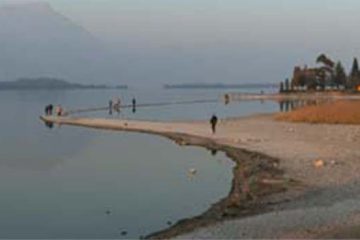 In view of the economic recession, particularly in the USA and European countries, the prices of frozen food in the international markets has fallen up to 40 to 45 percent posing a threat to the industry in Bangladesh.
In view of the economic recession, particularly in the USA and European countries, the prices of frozen food in the international markets has fallen up to 40 to 45 percent posing a threat to the industry in Bangladesh.
“A red alert hovers over the frozen foods industry,” said Sheikh Abdul Baki, Vice President of Bangladesh Frozen Foods Exporters’ Association (BFFEA).
He referred that export earning from frozen food recorded a fall by 18 percent till March 15 this year against the amount of Tk 3667 crore that Bangladesh earned during the same period last year.
Abdul Baki said about one and a half crores people depend on shrimp cultivation and its processing in Bangladesh. Of them, 12,00,000 people are directly involved with this industry.
The BFFEA leader further said that processing companies are incurring loss and farmers are showing their unwillingness to cultivate shrimp. They are shifting to cultivation of paddy and other crops.
It may be mentioned that 90 percent of the frozen food export comprises shrimp.
Abul Basher, Chief Executive Officer of the BFFEA said frozen foods export contributes about four percent to the GDP of the country.
He said there are 84 government-approved processing companies in Khulna, Satkhira, Chittagong and Cox’s Bazar; of which only 52 are in operation now.
This is the situation that prevails in the frozen foods industry now.
Shrimp cultivation was initiated in Satkhira district first in early 70s. Later, shrimp cultivation also spread to Khulna, Cox’s Bazar, Bagerhat and Barisal districts. Now, Golda (fresh water giant fish) is being cultivated in other districts also.
According to a statistic, black tiger (Bagda) is being cultivated on around 50,000 hectares of land.
Zafar Ali, 30 and Saddam Hossain, 25 working at Royal Hatchery and Nursery at Shalkhali at Ashashuni Upazila in Satkhira district, said they are getting only Tk 3000 each as salary which, they said, is not enough for them.
Saddam Hossain said shrimp fries collected from India, Shyamnagar, Kalindi River are sold at Satkhira town. Besides, shrimp fries also come from Cox’s Bazar by bus or plane.
Sheikh Abdus Sattar, 60, of Satkhira said most of the lands of Kaliganj, Shyamnagar, Ashashuni, Debhata in Satkhira district are used for shrimp cultivation.
He said fries of different fishes including shrimp automatically enter into the plots close to the rivers.
Nazim Uddin, 52 of Sarafpur village of Ashashuni upazila said they cannot supply water to their shrimp ghers as no water comes in the Morichap river for over five years.
Mohammad Ali, a gher businessman of the village Bakla of the same district said their business is under threat as there is no water in the river.
Referring to the fall in the shrimp price he said they are selling shrimp at the rate of Tk 350 to Tk 400 which was sold at Tk 500 to Tk 600 previously.
Shoilendra Sarker, 35, of village Maddya Kamalkathi, also a fish trader, said they are facing problems in running their business due to fall in the price.
“People involved in shrimp business are not in a good position. If middlemen (faria) counts loss, they adopt a dillydally tactic in paying the businessmen,” he said.
Md Abdul Gaffar, 40, of Katakhali said salty water damaging different crops, including paddy at Bashukhali, Godara, Baliapur, Kalibari areas in Satkhira district. He said that he lost crops from his one bigha of land for the same.
District Fisheries Officer Harun-or-Rashid said there are 17,904 ghers in Satkhira district with an average production of 265.50 kg per hectare.
A total of Tk 3,539 crore has been earned from export of shrimp from Satkhira alone, he said. The numbers of farmers and fishermen are 1,72,636 and 5,947 respectively.
There is a sharp debate among researchers about whether shrimp farming in the coastal regions of Bangladesh is viable or not.
A study carried out by Bangladesh Centre for Advance Studies in 2001 said the debate has produced two types of contending poles: the positive impacts and the negative impacts.
“One the one hand are those (Ahmed, 1998; Ali, 1990; Rahman, 1994; Nijera Kori, 1996, Hashemi, 1998; UBINIG, 1987) who consider that shrimp farming is largely responsible for the socio-economic, health and environmental problems resulting in unsustainable livelihood. Others reveal that shrimp culture has significantly changed the livelihood, and opened up a space for income and employment for the rural poor and marginal people,”
Leaders of different non-governmental organisations including Nijera Kori, Bangladesh Environmental Lawyers Association, Association for Land Reform and Development, Paikgachha Dhan-Machh-Paribesh Sangrakhkhon Committee, Karunamoyee Smriti Sangrakhkhon Committee and Dacope Upazila Nagarik Parishad in a seminar held in Khulna recently observed that expansion of commercial shrimp cultivation in the south-western costal region of the country has increased salinity in soil and water, resulting in acute crisis of safe drinking water.
They claimed that ‘various species of trees have got extinct, the number of cattle has decreased for want of fodder and most importantly, people are affected with diseases.
Shrimp expert Dr Mahmudul Karim, however, does not agree with the observation that shrimp cultivation destroys environment.
“It is not correct to pass gross remark that mangroves forest has been destructed and land owners became bankrupt due to shrimp cultivation. Every development work has a negative impact, so plan should be implemented in such a way that negative impact remains less,” he observed.
The shrimp expert thought destruction of natural environment in coastal area had been started in mid sixties by creating embankments there.
“People in the coastal areas started releasing shrimp fries in enclosed areas within the embankment early 70s,” he said.
Dr Karim, however, regretted that shrimp cultivation was initiated at Chokoria Sundarbans by destroying mangroves forest there.
He said people became interested in shrimp cultivation as they found it more profitable than paddy. Now, shrimp cultivators can cultivate paddy, fruits, vegetables and fish in the same land in phases and in a coordinated manner along with shrimp cultivation.
Dr Karim, also Managing Director of Shrimp Foundation, said protection of mangrove forest in the coastal area is important, particularly for cultivation of shrimp since it is the main nursing ground. None should destroy the forest for the sake of protection of ecology.
He said a large number of people including women are now engaged in shrimp cultivation. Besides, various industries like bamboo screen, net, sluice gate, baskets, processing plants, vans, cock-sheet box, feed and packaging have also been established centering shrimp cultivation.
Over Tk 550 crore is earned from fish export every year, of which 80 per cent come from shrimp, he said.
Dr Karim said shrimp cultivation is playing a positive role in creating employment and fulfilling a part of local nutrition demand.





